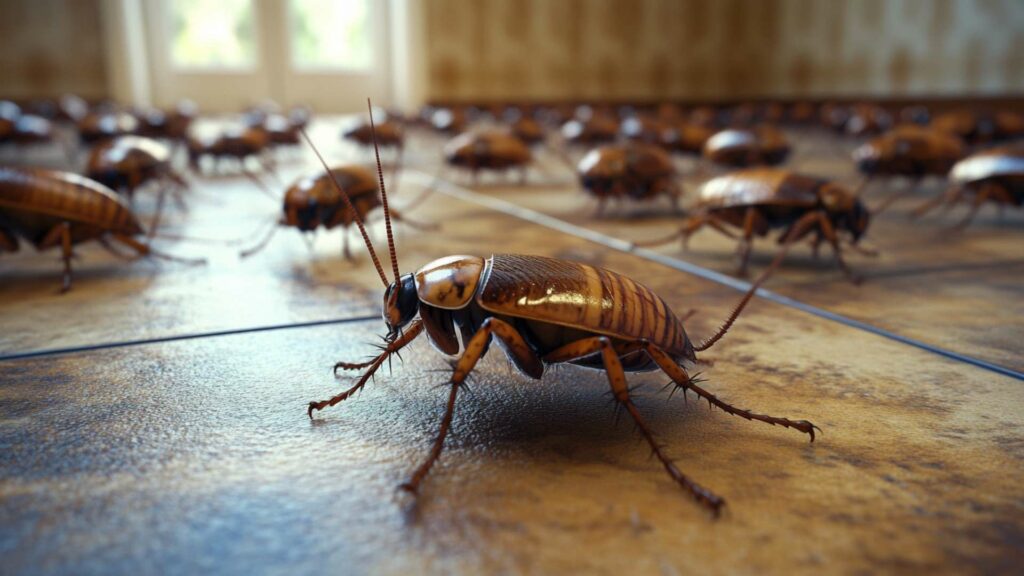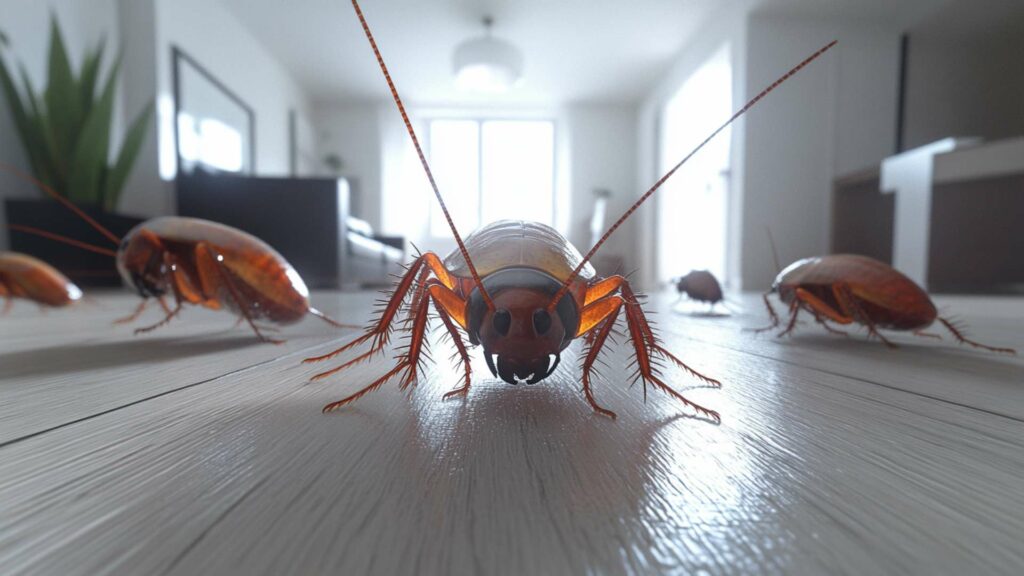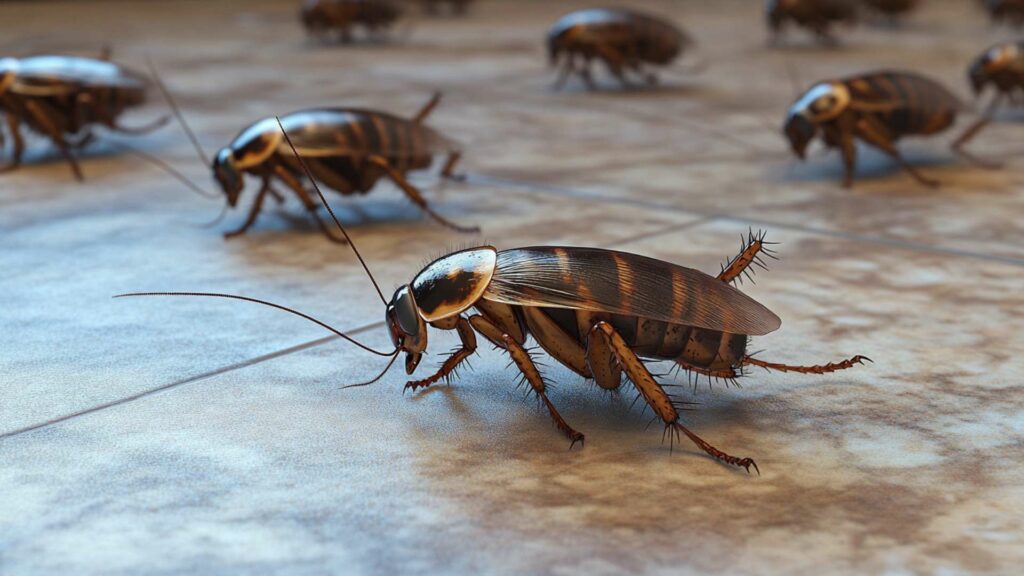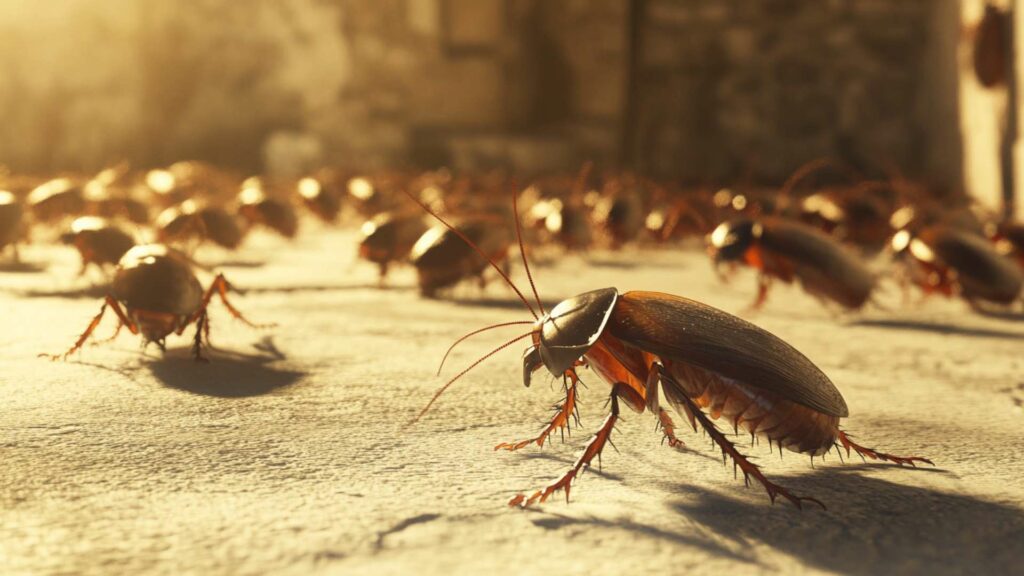A World of Miniature Creepiness
Ah, baby roaches – those tiny, wriggly critters that scuttle around with both curiosity and innocence. While the mere mention of their name might send shivers down your spine, understanding these miniature versions is crucial for dealing with a cockroach infestation. So, let’s embark on a journey into the fascinating world of baby roaches.
Uncover the Truth About Roach Infestations! Learn how to identify the telltale roach infestation signs and detection methods to protect your home from these pesky invaders.
Brief Overview of Roach Life Cycle
From Eggs to Unwelcome Houseguests
To truly comprehend baby roaches, we must first grasp the overall cockroach life cycle. It all begins when a female cockroach lays an egg capsule called an ootheca. Think of these capsules as tiny ticking time bombs waiting to hatch into hundreds of little troublemakers.
Different cockroach species have varying reproductive habits and produce diverse numbers of eggs per capsule. Once the eggs are laid, they undergo an incubation period until they’re ready to unleash their crawling army upon the world.
After hatching, these minuscule creatures are known as cockroach nymphs and go through several molting stages to reach adulthood. Baby cockroaches usually resemble scaled-down versions of their adult counterparts but may lack certain features like wings.
Importance of Understanding Baby Roaches

The Key to Effective Pest Control
Now you might be wondering: why should I bother learning about something so seemingly insignificant? Well, my friend, understanding baby roaches is vital in combating these harmful pests effectively. By identifying cockroach nymphs in your home or workplace early on, you can implement targeted intervention strategies before they grow into fully-fledged nuisances.
Furthermore, comprehending the appearance and behavior patterns specific to different species’ offspring allows you to narrow down the type of infestation you’re dealing with. This knowledge is crucial because, for instance, identifying baby German cockroaches requires different tactics than handling oriental roach nymphs or brown-banded cockroaches.
Delving into the world of baby roaches might not be the most pleasant journey, but it’s an essential one. By understanding their life cycle and characteristics, you gain a significant advantage in combating these unwanted guests effectively.
So let us now venture forth to explore the appearance and physical features of these miniature creepy crawlies in more detail. Remember, knowledge is power when it comes to turning your home into a roach-free sanctuary!
The appearance of baby roaches

Size and color variations among different species
When it comes to the appearance of baby roaches, there are fascinating variations in size and color among different species. Each species of cockroach also has its own unique characteristics that distinguish their offspring from one another. Let’s delve into some of the most common types of baby cockroaches and how they look.
German cockroach babies: small and light brown with dark stripes
German cockroach nymphs are small, measuring about 1/8 to 1/4 inch in length. These little critters are usually lightreddish brown color in color with two dark stripes running down their backs.
The stripes act as camouflage, providing them some protection by blending into their surroundings. German cockroach nymphs have thin antennae that help them navigate their environment as they scurry around.
American cockroach babies: larger and reddish-brown with a yellowish band on the back
Baby American cockroaches tend to be larger than German cockroach nymphs, ranging from 1/4 to 1/2 inch in length. They have a reddish-brown hue and possess a distinct yellowish band on the back of their heads, which sets them apart from others. These little ones sport six spiny legs that aid them in quick movements as they explore their surroundings.
Oriental cockroach babies: dark brown or black, similar in appearance to adults
Baby Oriental roaches share a striking resemblance to adult individuals right from birth. They are born either dark brown or black, much like their adult counterparts pale brown color. Measuring around 1/4 to 1/2 inch long, these nymphs also possess six spiny legs and thin antennae that help them detect potential food sources nearby.
When it comes to the appearance of baby cockroaches, their size and colors can vary depending on the species. German cockroach nymphs are small with light brown bodies and dark stripes, while American american cockroach nymphs andbabies are larger with reddish-brown bodies and a yellowish band on their heads.
Oriental cockroach nymphs closely resemble adult individuals, being dark brown or black in color. Understanding these variations can help identify different species of cockroaches and aid in effective pest management strategies.
Physical Features of Baby Roaches
Body Structure and Shape
Baby roaches, regardless of their species, possess distinct physical characteristics that distinguish them from their adult counterparts. These young insects have bodies similar in shape to adult roaches but are considerably smaller in size.
Picture a miniature version of the adult cockroach scurrying around, its presence almost cute if it weren’t for the fact that it belonged to a family of pests. The bodies of baby roaches are covered in a soft exoskeleton that gradually hardens as they mature into adulthood.
This exoskeleton provides some protection against external threats while allowing flexibility for movement. Although initially vulnerable due to their soft shells, baby roaches swiftly develop resilience as their exoskeletons toughen over time.
Segmented Body with Six Legs, Two Antennae, and a Pair of Cerci at the Rear End

Like their adult counterparts, baby roaches tend to have segmented bodies consisting of three distinct sections: head, thorax, and abdomen. Their bodies also bear six spiny legs on which they scuttle across surfaces with unwavering speed and agility. Perched atop their heads are thin antennae that serve as sensory organs capable of detecting various stimuli in their environment.
These antennae actively aid the baby cockroach in navigating its surroundings and locating food sources or potential threats. At the rear end of a baby roach’s abdomen lies a pair of cerci.
These structures resemble small appendages or filaments extending outward from either side. While their precise function is not entirely understood, it is believed that cerci play a role in sensory perception, possibly assisting in detecting vibrations or changes in air currents.
Overall, the physical features exhibited by baby roaches contribute to their remarkable ability to adapt and survive within various environments. As they grow older and progress through different developmental stages, their bodies transform, eventually resembling the appearance of adult roaches.
Developmental Stages of Baby Roaches
The Miracle of Life: From Eggs to Nymphs
Deep within the mysterious world of roaches, lies an incredible journey of growth and transformation. Baby roaches, known as nymphs, undergo several developmental stages before maturing into the formidable adults we so often dread. Let’s delve into these stages and discover the wonders that unfold.
Egg Stage: The Beginning
Before we can witness the emergence of baby roaches, we must first explore young cockroaches from their humble beginnings in the egg stage. Female roaches proudly produce oothecae, which are sturdy capsules that protect their precious offspring. These oothecae are composed of a protein substance secreted by the female and harden over time.
The number of eggs contained within each capsule varies depending on the species. For instance, German cockroach oothecae can house up to 40 eggs, while American cockroaches tend to carry around 14 eggs per capsule.
Oriental cockroaches typically hold between 16 to 18 eggs in each ootheca. It is truly awe-inspiring how nature adapts its strategies for reproduction.
Nymph Stage: The Journey Begins
Once it’s time for hatching, these resilient creatures make their way into the world as nymphs – miniature versions of their adult counterparts but without wings at this stage. These curious nymphs possess a remarkable resemblance to adult roaches in terms of structure and appearance. Nymphs vary slightly among species but generally have soft exoskeletons that harden as they mature through successive molts.
At this crucial stage, they rely heavily on their caretaker parent or other adult roaches for guidance and protection against predators like insect growth regulators and bed bugs. It’s fascinating to observe how baby cockroaches start their lives seeking support from the roach community.
Behavior and Habits of Baby Roaches
Adaptations for Survival in Their Environment
Baby roaches, whether they are German cockroaches, American cockroaches, or Oriental cockroaches, possess remarkable adaptations that enable them to survive and thrive in their environment. One key behavior of baby roaches is their nocturnal nature.
These tiny creatures are active during the night and prefer to seek shelter during daylight hours. This behavior helps protect them from predators and unfavorable environmental conditions.
Baby Roaches Seek Shelter to Ensure Survival
During the day, baby roaches instinctively search for dark crevices and hidden places where they can hide until it’s safe to come out at night. They tend to gravitate towards cozy spots like cracks in walls, under appliances or furniture, inside cabinets or drawers, or even within electrical outlets. By seeking shelter in these secluded areas, baby roaches minimize their exposure to potential threats while maximizing their chances of survival.
The Importance of Staying Close to Adults for Protection
Baby roaches have a strong instinctual drive to stay close to their mother or other adult female cockroaches for protection. These adult figures offer guidance and support by showing them where food sources are located and how to avoid danger.
The presence of adults also provides a layer of protection against predators that may be deterred by larger-sized roaches nearby. This social behavior helps increase the chances of survival for baby roaches during their vulnerable early stages.
Dietary Preferences and Feeding Habits
Baby Cockroaches Consume Similar Foods as Adults
When it comes to sustenance, baby cockroaches have similar tastes as their adult counterparts. They are opportunistic scavengers that will feed on almost anything organic in nature.
Common food sources for baby roaches include crumbs, food debris, decaying matter, and even pet food left out overnight. The ability to consume a wide range of food ensures that they have access to sustenance necessary for growth and development.
The Role of Baby Roaches as Scavengers

Like their adult counterparts, the baby roach and cockroaches play a vital role in the ecosystem as efficient scavengers. Their feeding habits help in the decomposition process of organic matter and contribute to nutrient cycling in nature. While baby roaches may not be desirable house guests, it’s important to recognize their ecological value and consider implementing effective pest control strategies that focus on eliminating the conditions that attract them.
Conclusion
Understanding the behavior and habits of baby roaches provides valuable insights into their survival strategies. These tiny creatures have adapted themselves over generations to thrive in various environments. Their nocturnal activity patterns, instinctual drive to seek shelter during daylight hours, and reliance on adults for protection all contribute to their chances of survival.
Additionally, their dietary preferences as generalist scavengers help maintain balance within ecosystems. By appreciating the complexities of these creatures’ lives, we can develop more effective strategies for managing infestations while fostering greater respect for the intricate workings of nature.
Get rid of cockroaches using D-Termination: The leading pest control service in Las Vegas!

Need assistance with cockroach issues? Look no further than D-Termination. Our skilled professionals excel in eradicating cockroach infestations, bringing back cleanliness and tranquility. Bid farewell to cockroaches—opt for D-Termination for efficient pest control right away!
Reach out to us at 702-919-6310 or visit dtermination.com to schedule your cockroach control service and take back your environment from these persistent pests.
Frequently Asked Questions:
Baby cockroaches can be identified by their smaller size, lighter coloration, and underdeveloped wings.
Beetles, booklice, and other small insects can be mistaken for baby cockroaches.
Yes, baby cockroaches are visible, although they may be harder to spot due to their small size.
Baby cockroaches tend to hide in dark, damp areas such as cracks, crevices, and behind appliances. They have a similar appearance to adult cockroaches, but with a more translucent and lighter coloration.







